Outbreaks of Bacterial Meningitis in African Countries
VerifiedAdded on 2022/11/25
|14
|4233
|221
AI Summary
This article discusses the outbreaks of bacterial meningitis in African countries, highlighting the policy implications and prevention methods. It provides an overview of the disease, its causes, symptoms, diagnosis, treatment, and prevention. Find study material and solved assignments on Desklib.
Contribute Materials
Your contribution can guide someone’s learning journey. Share your
documents today.
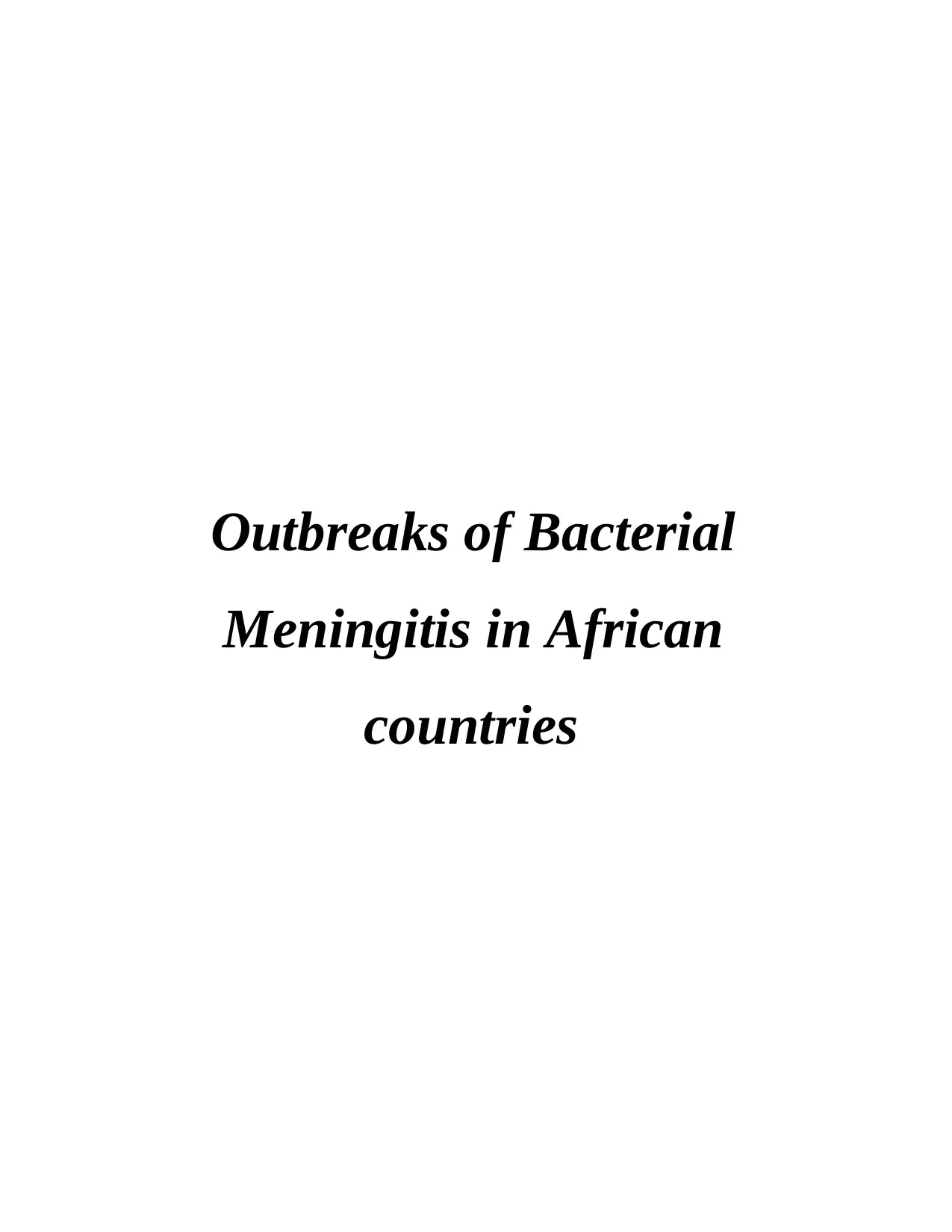
Outbreaks of Bacterial
Meningitis in African
countries
Meningitis in African
countries
Secure Best Marks with AI Grader
Need help grading? Try our AI Grader for instant feedback on your assignments.

TABLE OF CONTENTS
INTRODUCTION...........................................................................................................................3
MAIN BODY..................................................................................................................................3
Outbreaks of Bacterial Meningitis in Africa...............................................................................3
Policy Implications......................................................................................................................9
CONCLUSION..............................................................................................................................12
REFERENCES..............................................................................................................................13
INTRODUCTION...........................................................................................................................3
MAIN BODY..................................................................................................................................3
Outbreaks of Bacterial Meningitis in Africa...............................................................................3
Policy Implications......................................................................................................................9
CONCLUSION..............................................................................................................................12
REFERENCES..............................................................................................................................13
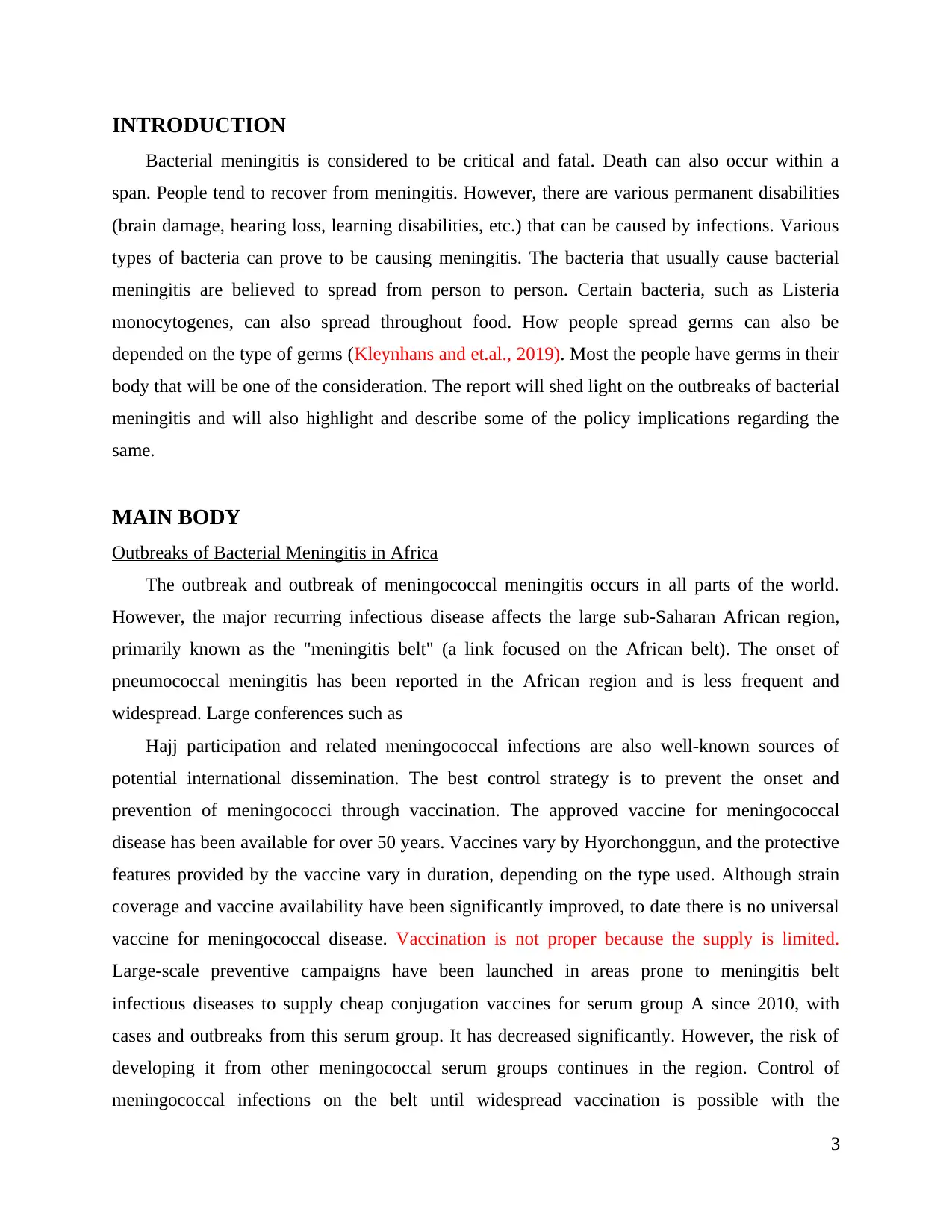
INTRODUCTION
Bacterial meningitis is considered to be critical and fatal. Death can also occur within a
span. People tend to recover from meningitis. However, there are various permanent disabilities
(brain damage, hearing loss, learning disabilities, etc.) that can be caused by infections. Various
types of bacteria can prove to be causing meningitis. The bacteria that usually cause bacterial
meningitis are believed to spread from person to person. Certain bacteria, such as Listeria
monocytogenes, can also spread throughout food. How people spread germs can also be
depended on the type of germs (Kleynhans and et.al., 2019). Most the people have germs in their
body that will be one of the consideration. The report will shed light on the outbreaks of bacterial
meningitis and will also highlight and describe some of the policy implications regarding the
same.
MAIN BODY
Outbreaks of Bacterial Meningitis in Africa
The outbreak and outbreak of meningococcal meningitis occurs in all parts of the world.
However, the major recurring infectious disease affects the large sub-Saharan African region,
primarily known as the "meningitis belt" (a link focused on the African belt). The onset of
pneumococcal meningitis has been reported in the African region and is less frequent and
widespread. Large conferences such as
Hajj participation and related meningococcal infections are also well-known sources of
potential international dissemination. The best control strategy is to prevent the onset and
prevention of meningococci through vaccination. The approved vaccine for meningococcal
disease has been available for over 50 years. Vaccines vary by Hyorchonggun, and the protective
features provided by the vaccine vary in duration, depending on the type used. Although strain
coverage and vaccine availability have been significantly improved, to date there is no universal
vaccine for meningococcal disease. Vaccination is not proper because the supply is limited.
Large-scale preventive campaigns have been launched in areas prone to meningitis belt
infectious diseases to supply cheap conjugation vaccines for serum group A since 2010, with
cases and outbreaks from this serum group. It has decreased significantly. However, the risk of
developing it from other meningococcal serum groups continues in the region. Control of
meningococcal infections on the belt until widespread vaccination is possible with the
3
Bacterial meningitis is considered to be critical and fatal. Death can also occur within a
span. People tend to recover from meningitis. However, there are various permanent disabilities
(brain damage, hearing loss, learning disabilities, etc.) that can be caused by infections. Various
types of bacteria can prove to be causing meningitis. The bacteria that usually cause bacterial
meningitis are believed to spread from person to person. Certain bacteria, such as Listeria
monocytogenes, can also spread throughout food. How people spread germs can also be
depended on the type of germs (Kleynhans and et.al., 2019). Most the people have germs in their
body that will be one of the consideration. The report will shed light on the outbreaks of bacterial
meningitis and will also highlight and describe some of the policy implications regarding the
same.
MAIN BODY
Outbreaks of Bacterial Meningitis in Africa
The outbreak and outbreak of meningococcal meningitis occurs in all parts of the world.
However, the major recurring infectious disease affects the large sub-Saharan African region,
primarily known as the "meningitis belt" (a link focused on the African belt). The onset of
pneumococcal meningitis has been reported in the African region and is less frequent and
widespread. Large conferences such as
Hajj participation and related meningococcal infections are also well-known sources of
potential international dissemination. The best control strategy is to prevent the onset and
prevention of meningococci through vaccination. The approved vaccine for meningococcal
disease has been available for over 50 years. Vaccines vary by Hyorchonggun, and the protective
features provided by the vaccine vary in duration, depending on the type used. Although strain
coverage and vaccine availability have been significantly improved, to date there is no universal
vaccine for meningococcal disease. Vaccination is not proper because the supply is limited.
Large-scale preventive campaigns have been launched in areas prone to meningitis belt
infectious diseases to supply cheap conjugation vaccines for serum group A since 2010, with
cases and outbreaks from this serum group. It has decreased significantly. However, the risk of
developing it from other meningococcal serum groups continues in the region. Control of
meningococcal infections on the belt until widespread vaccination is possible with the
3

appropriate vaccine, primarily to detect rapid onset, efficient monitoring and rapid to identify the
causative agent of the onset Depends on vaccination with a large number of reactions. At the
heart of a timely and effective response is a country-by-country ratio and a rapid supply of
meningococcal vaccine. WHO and partners will work together to support early detection of
cases, laboratory confirmation, and national capacity building for rapid and effective response to
onset to mitigate the impact. Through the International Coordinating Group on Vaccine Delivery
to Control Infectious Disease Meningitis (ICG), WHO and partners will manage and coordinate
urgent vaccine supply and antibiotic delivery to the country during major onset periods to do.
Onset of Invasive Meningococcal Disease Toolbox
A new roadmap for combating meningitis by 2030 is to eliminate one of the vision's goals,
the meningitis epidemic by 2030. Using this roadmap, WHO and partners have achieved this
goal for the country by enabling the development of affordable vaccines, enhanced accessibility
and scope, effective preventive strategies and targeted intervention. We will support you so that
you can.
Meningitis is basically a severe infection of the meninges, which is a membrane which covers
the spinal cord and brain. It is a deadly disease and remains a significant public health problem.
The disease can be due to variety of pathogens, such as bacteria, fungi, and viruses, but bacterial
meningitis has the highest global burden.
Several bacteria can cause meningitis. Pneumococci, influenzae, and meningococci are most
often seen. Meningococcus, which causes meningococcal meningitis, is something that can cause
mass epidemics. The identified meningococcal serotypes are 12, of which 6 (A, B, C, W, X, Y)
can lead to epidemikku (Okomo and et.al., 2020).
Meningococcal meningitis has also a great impact on people belonging to any age group, but it
especially affects the infants, preschool children, and adolescents. The disease is likely to occur
not only in a specific situation but in numerous situations, from sporadic cases to epidemics of
large scale in small populations around the world, and is seasonal. Geographic distribution and
epidemikku potential depend on serotype. The greatest burden of meningococcal meningitis
occurs in the meningitis band, which is a region of sub-Saharan Africa that stretches from
western Senegal to eastern Ethiopia. It can cause various diseases. Invasive Meningococcal
Disease (IMD) represents a range of invasive diseases induced by N. meningitidis, including
4
causative agent of the onset Depends on vaccination with a large number of reactions. At the
heart of a timely and effective response is a country-by-country ratio and a rapid supply of
meningococcal vaccine. WHO and partners will work together to support early detection of
cases, laboratory confirmation, and national capacity building for rapid and effective response to
onset to mitigate the impact. Through the International Coordinating Group on Vaccine Delivery
to Control Infectious Disease Meningitis (ICG), WHO and partners will manage and coordinate
urgent vaccine supply and antibiotic delivery to the country during major onset periods to do.
Onset of Invasive Meningococcal Disease Toolbox
A new roadmap for combating meningitis by 2030 is to eliminate one of the vision's goals,
the meningitis epidemic by 2030. Using this roadmap, WHO and partners have achieved this
goal for the country by enabling the development of affordable vaccines, enhanced accessibility
and scope, effective preventive strategies and targeted intervention. We will support you so that
you can.
Meningitis is basically a severe infection of the meninges, which is a membrane which covers
the spinal cord and brain. It is a deadly disease and remains a significant public health problem.
The disease can be due to variety of pathogens, such as bacteria, fungi, and viruses, but bacterial
meningitis has the highest global burden.
Several bacteria can cause meningitis. Pneumococci, influenzae, and meningococci are most
often seen. Meningococcus, which causes meningococcal meningitis, is something that can cause
mass epidemics. The identified meningococcal serotypes are 12, of which 6 (A, B, C, W, X, Y)
can lead to epidemikku (Okomo and et.al., 2020).
Meningococcal meningitis has also a great impact on people belonging to any age group, but it
especially affects the infants, preschool children, and adolescents. The disease is likely to occur
not only in a specific situation but in numerous situations, from sporadic cases to epidemics of
large scale in small populations around the world, and is seasonal. Geographic distribution and
epidemikku potential depend on serotype. The greatest burden of meningococcal meningitis
occurs in the meningitis band, which is a region of sub-Saharan Africa that stretches from
western Senegal to eastern Ethiopia. It can cause various diseases. Invasive Meningococcal
Disease (IMD) represents a range of invasive diseases induced by N. meningitidis, including
4
Secure Best Marks with AI Grader
Need help grading? Try our AI Grader for instant feedback on your assignments.
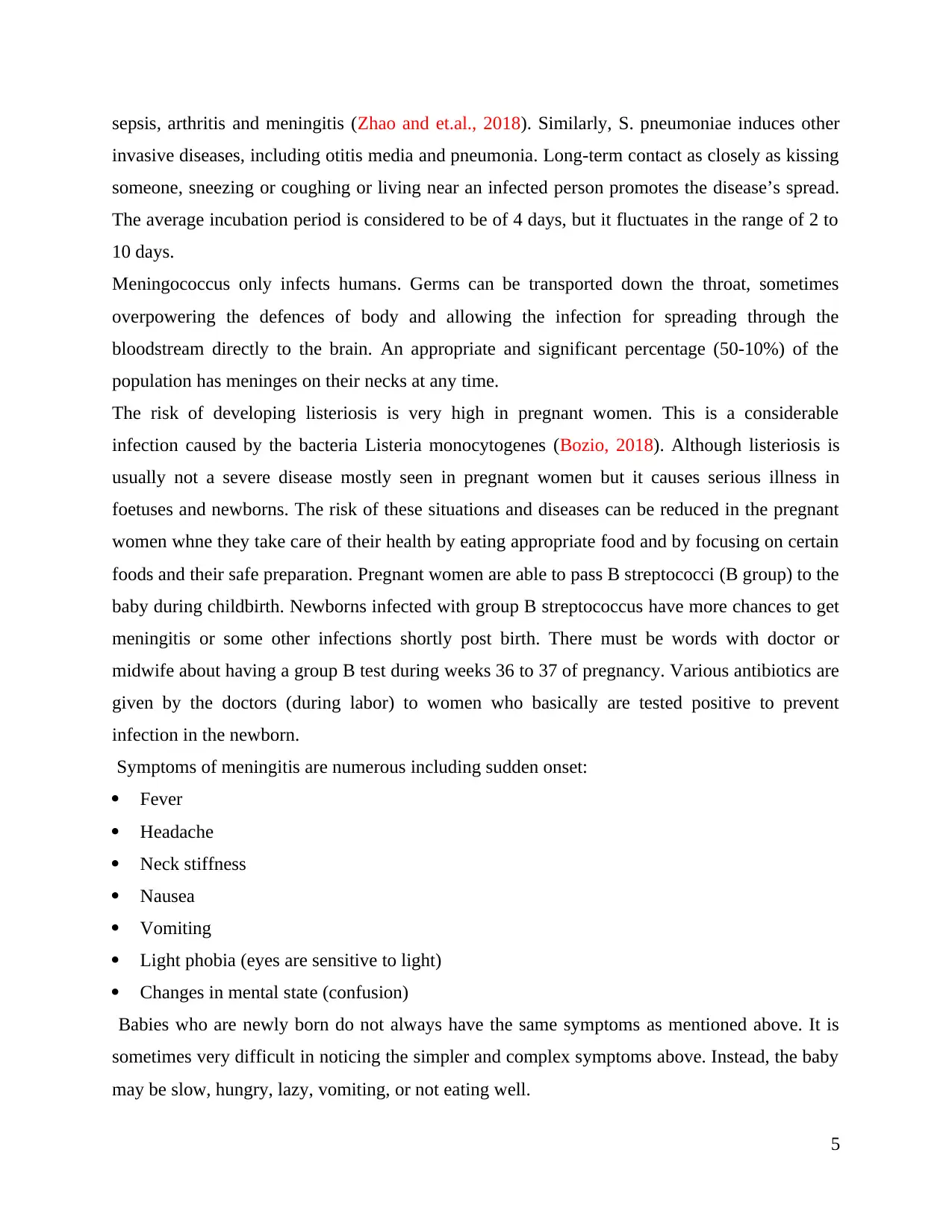
sepsis, arthritis and meningitis (Zhao and et.al., 2018). Similarly, S. pneumoniae induces other
invasive diseases, including otitis media and pneumonia. Long-term contact as closely as kissing
someone, sneezing or coughing or living near an infected person promotes the disease’s spread.
The average incubation period is considered to be of 4 days, but it fluctuates in the range of 2 to
10 days.
Meningococcus only infects humans. Germs can be transported down the throat, sometimes
overpowering the defences of body and allowing the infection for spreading through the
bloodstream directly to the brain. An appropriate and significant percentage (50-10%) of the
population has meninges on their necks at any time.
The risk of developing listeriosis is very high in pregnant women. This is a considerable
infection caused by the bacteria Listeria monocytogenes (Bozio, 2018). Although listeriosis is
usually not a severe disease mostly seen in pregnant women but it causes serious illness in
foetuses and newborns. The risk of these situations and diseases can be reduced in the pregnant
women whne they take care of their health by eating appropriate food and by focusing on certain
foods and their safe preparation. Pregnant women are able to pass B streptococci (B group) to the
baby during childbirth. Newborns infected with group B streptococcus have more chances to get
meningitis or some other infections shortly post birth. There must be words with doctor or
midwife about having a group B test during weeks 36 to 37 of pregnancy. Various antibiotics are
given by the doctors (during labor) to women who basically are tested positive to prevent
infection in the newborn.
Symptoms of meningitis are numerous including sudden onset:
Fever
Headache
Neck stiffness
Nausea
Vomiting
Light phobia (eyes are sensitive to light)
Changes in mental state (confusion)
Babies who are newly born do not always have the same symptoms as mentioned above. It is
sometimes very difficult in noticing the simpler and complex symptoms above. Instead, the baby
may be slow, hungry, lazy, vomiting, or not eating well.
5
invasive diseases, including otitis media and pneumonia. Long-term contact as closely as kissing
someone, sneezing or coughing or living near an infected person promotes the disease’s spread.
The average incubation period is considered to be of 4 days, but it fluctuates in the range of 2 to
10 days.
Meningococcus only infects humans. Germs can be transported down the throat, sometimes
overpowering the defences of body and allowing the infection for spreading through the
bloodstream directly to the brain. An appropriate and significant percentage (50-10%) of the
population has meninges on their necks at any time.
The risk of developing listeriosis is very high in pregnant women. This is a considerable
infection caused by the bacteria Listeria monocytogenes (Bozio, 2018). Although listeriosis is
usually not a severe disease mostly seen in pregnant women but it causes serious illness in
foetuses and newborns. The risk of these situations and diseases can be reduced in the pregnant
women whne they take care of their health by eating appropriate food and by focusing on certain
foods and their safe preparation. Pregnant women are able to pass B streptococci (B group) to the
baby during childbirth. Newborns infected with group B streptococcus have more chances to get
meningitis or some other infections shortly post birth. There must be words with doctor or
midwife about having a group B test during weeks 36 to 37 of pregnancy. Various antibiotics are
given by the doctors (during labor) to women who basically are tested positive to prevent
infection in the newborn.
Symptoms of meningitis are numerous including sudden onset:
Fever
Headache
Neck stiffness
Nausea
Vomiting
Light phobia (eyes are sensitive to light)
Changes in mental state (confusion)
Babies who are newly born do not always have the same symptoms as mentioned above. It is
sometimes very difficult in noticing the simpler and complex symptoms above. Instead, the baby
may be slow, hungry, lazy, vomiting, or not eating well.
5

For small babies, doctors can find swollen astronomical (soft spots on the baby's head) and
abnormal reflexes. If the baby or child seems to have these symptoms, then the doctor is to be
contacted on urgent basis. This is also evident that the symptoms regarding bacterial meningitis
may appear immediately or after several days. Generally, this can be evaluated that it occurs
within 3-7 days after exposure. It is also examined that the symptoms of bacterial meningitis post
are often very severe (seizures, coma, etc.). So, if a person thinks that he or she has meningitis,
see the doctor as soon as possible.
Treatment
Antibiotics are mainly used for treating bacterial meningitis by doctors. This is very important
that the treatment is started as soon as possible on urgent basis.
Prevention
The vaccine is an effective way for protecting against specific types of bacterial meningitis.
There are vaccines against three types of bacteria which can contribute towards occurring of
meningitis.
Meningococcal Vaccine helps prevent against Meningococcal, Pneumococcal Vaccine Helps
Prevent against S. The pneumoniae Hib vaccine helps prevent Hib.
Like other vaccines, vaccines that prevent these types of bacteria is not 100% perfect and
effective. Vaccines do not protect against all types of strains of each bacterium. For the above
mentioned reasons, vaccinated people can still get bacterial meningitis.
Pregnant women should consult their doctor or midwife for testing for group B streptococci.
Women are tested during 36th and 37th weeks of gestation. Doctors administer antibiotics to
women who are tested positive (during delivery) for preventing group B streptococci from being
transmitted to newborns. Pregnant women can also contribute towards reducing the risk of
meningitis due to L. monocytogenes (Hitchings and et.al., 2019). Women should also avoid
certain foods and prepare other foods safely during pregnancy.
If someone is suffering from bacterial meningitis, the doctor can also recommend antibiotics so
that others don't hurt. Doctors call this prevention. CDC recommends prevention in the following
cases:
6
abnormal reflexes. If the baby or child seems to have these symptoms, then the doctor is to be
contacted on urgent basis. This is also evident that the symptoms regarding bacterial meningitis
may appear immediately or after several days. Generally, this can be evaluated that it occurs
within 3-7 days after exposure. It is also examined that the symptoms of bacterial meningitis post
are often very severe (seizures, coma, etc.). So, if a person thinks that he or she has meningitis,
see the doctor as soon as possible.
Treatment
Antibiotics are mainly used for treating bacterial meningitis by doctors. This is very important
that the treatment is started as soon as possible on urgent basis.
Prevention
The vaccine is an effective way for protecting against specific types of bacterial meningitis.
There are vaccines against three types of bacteria which can contribute towards occurring of
meningitis.
Meningococcal Vaccine helps prevent against Meningococcal, Pneumococcal Vaccine Helps
Prevent against S. The pneumoniae Hib vaccine helps prevent Hib.
Like other vaccines, vaccines that prevent these types of bacteria is not 100% perfect and
effective. Vaccines do not protect against all types of strains of each bacterium. For the above
mentioned reasons, vaccinated people can still get bacterial meningitis.
Pregnant women should consult their doctor or midwife for testing for group B streptococci.
Women are tested during 36th and 37th weeks of gestation. Doctors administer antibiotics to
women who are tested positive (during delivery) for preventing group B streptococci from being
transmitted to newborns. Pregnant women can also contribute towards reducing the risk of
meningitis due to L. monocytogenes (Hitchings and et.al., 2019). Women should also avoid
certain foods and prepare other foods safely during pregnancy.
If someone is suffering from bacterial meningitis, the doctor can also recommend antibiotics so
that others don't hurt. Doctors call this prevention. CDC recommends prevention in the following
cases:
6

If you are in close contact with a person with meningitidis-induced meningitis, if you are at high
risk for a family member, especially those with a serious Hib infection, prevent it with your
doctor or community health department. We recommend what you should receive.
Maintaining various healthy habits can also help in protecting the person with meningitis which
is as follows:
Avoid smoking and avoid smoking.
Get enough rest.
Close contact with the sick people must be avoided.
Toddler
Elderly
Immune system weak
Spleen missing or not working properly
Acute bacterial meningitis is considered to be the most prominent form of meningitis. About
80% of all cases are under the category of acute bacterial meningococcus. This can also be
examined that bacterial meningitis can become life-threatening. The tissue around the brain for
infections can be swelled. This can interfere with turning flow of blood and cause seizures and
strokes.
This can also be evident that the children who belong to age group of 1 month and 2 years are
most prone to or susceptible to bacterial meningitis.
Adults with certain risk factors are also susceptible. Your risk increases if you have chronic nose
and ear infections, abuse alcohol, have a head injury or get pneumococcal pneumonia.
The weakened immune system can also increase the risks such as a splenectomy, who is taking
corticosteroids for kidney failure or has sickle cell anemia (Mustapha and Harrison, 2018).
This can also be interpreted that people who have had brain or spine surgery or have extensive
blood infections are also at an increased risk of bacterial meningitis. Bacterial meningitis is also
considered to be occurred in living conditions such as coming in close contact with others, such
as in college dormitories and barracks.
Cause
The most common bacteria that cause bacterial meningitis may also be found nasal breathing
without causing any harm to the environment. At some times, meningitis occurs for very
7
risk for a family member, especially those with a serious Hib infection, prevent it with your
doctor or community health department. We recommend what you should receive.
Maintaining various healthy habits can also help in protecting the person with meningitis which
is as follows:
Avoid smoking and avoid smoking.
Get enough rest.
Close contact with the sick people must be avoided.
Toddler
Elderly
Immune system weak
Spleen missing or not working properly
Acute bacterial meningitis is considered to be the most prominent form of meningitis. About
80% of all cases are under the category of acute bacterial meningococcus. This can also be
examined that bacterial meningitis can become life-threatening. The tissue around the brain for
infections can be swelled. This can interfere with turning flow of blood and cause seizures and
strokes.
This can also be evident that the children who belong to age group of 1 month and 2 years are
most prone to or susceptible to bacterial meningitis.
Adults with certain risk factors are also susceptible. Your risk increases if you have chronic nose
and ear infections, abuse alcohol, have a head injury or get pneumococcal pneumonia.
The weakened immune system can also increase the risks such as a splenectomy, who is taking
corticosteroids for kidney failure or has sickle cell anemia (Mustapha and Harrison, 2018).
This can also be interpreted that people who have had brain or spine surgery or have extensive
blood infections are also at an increased risk of bacterial meningitis. Bacterial meningitis is also
considered to be occurred in living conditions such as coming in close contact with others, such
as in college dormitories and barracks.
Cause
The most common bacteria that cause bacterial meningitis may also be found nasal breathing
without causing any harm to the environment. At some times, meningitis occurs for very
7
Paraphrase This Document
Need a fresh take? Get an instant paraphrase of this document with our AI Paraphraser
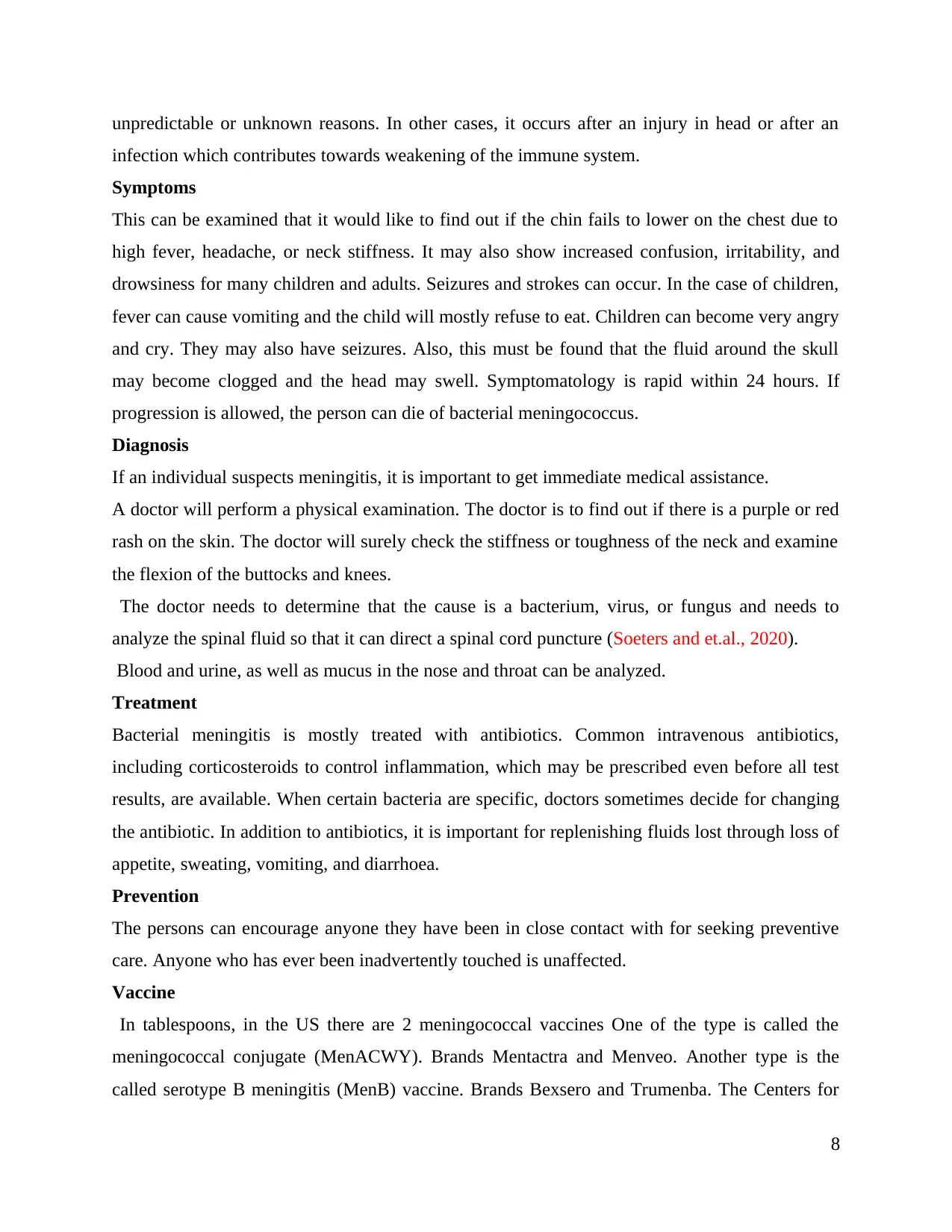
unpredictable or unknown reasons. In other cases, it occurs after an injury in head or after an
infection which contributes towards weakening of the immune system.
Symptoms
This can be examined that it would like to find out if the chin fails to lower on the chest due to
high fever, headache, or neck stiffness. It may also show increased confusion, irritability, and
drowsiness for many children and adults. Seizures and strokes can occur. In the case of children,
fever can cause vomiting and the child will mostly refuse to eat. Children can become very angry
and cry. They may also have seizures. Also, this must be found that the fluid around the skull
may become clogged and the head may swell. Symptomatology is rapid within 24 hours. If
progression is allowed, the person can die of bacterial meningococcus.
Diagnosis
If an individual suspects meningitis, it is important to get immediate medical assistance.
A doctor will perform a physical examination. The doctor is to find out if there is a purple or red
rash on the skin. The doctor will surely check the stiffness or toughness of the neck and examine
the flexion of the buttocks and knees.
The doctor needs to determine that the cause is a bacterium, virus, or fungus and needs to
analyze the spinal fluid so that it can direct a spinal cord puncture (Soeters and et.al., 2020).
Blood and urine, as well as mucus in the nose and throat can be analyzed.
Treatment
Bacterial meningitis is mostly treated with antibiotics. Common intravenous antibiotics,
including corticosteroids to control inflammation, which may be prescribed even before all test
results, are available. When certain bacteria are specific, doctors sometimes decide for changing
the antibiotic. In addition to antibiotics, it is important for replenishing fluids lost through loss of
appetite, sweating, vomiting, and diarrhoea.
Prevention
The persons can encourage anyone they have been in close contact with for seeking preventive
care. Anyone who has ever been inadvertently touched is unaffected.
Vaccine
In tablespoons, in the US there are 2 meningococcal vaccines One of the type is called the
meningococcal conjugate (MenACWY). Brands Mentactra and Menveo. Another type is the
called serotype B meningitis (MenB) vaccine. Brands Bexsero and Trumenba. The Centers for
8
infection which contributes towards weakening of the immune system.
Symptoms
This can be examined that it would like to find out if the chin fails to lower on the chest due to
high fever, headache, or neck stiffness. It may also show increased confusion, irritability, and
drowsiness for many children and adults. Seizures and strokes can occur. In the case of children,
fever can cause vomiting and the child will mostly refuse to eat. Children can become very angry
and cry. They may also have seizures. Also, this must be found that the fluid around the skull
may become clogged and the head may swell. Symptomatology is rapid within 24 hours. If
progression is allowed, the person can die of bacterial meningococcus.
Diagnosis
If an individual suspects meningitis, it is important to get immediate medical assistance.
A doctor will perform a physical examination. The doctor is to find out if there is a purple or red
rash on the skin. The doctor will surely check the stiffness or toughness of the neck and examine
the flexion of the buttocks and knees.
The doctor needs to determine that the cause is a bacterium, virus, or fungus and needs to
analyze the spinal fluid so that it can direct a spinal cord puncture (Soeters and et.al., 2020).
Blood and urine, as well as mucus in the nose and throat can be analyzed.
Treatment
Bacterial meningitis is mostly treated with antibiotics. Common intravenous antibiotics,
including corticosteroids to control inflammation, which may be prescribed even before all test
results, are available. When certain bacteria are specific, doctors sometimes decide for changing
the antibiotic. In addition to antibiotics, it is important for replenishing fluids lost through loss of
appetite, sweating, vomiting, and diarrhoea.
Prevention
The persons can encourage anyone they have been in close contact with for seeking preventive
care. Anyone who has ever been inadvertently touched is unaffected.
Vaccine
In tablespoons, in the US there are 2 meningococcal vaccines One of the type is called the
meningococcal conjugate (MenACWY). Brands Mentactra and Menveo. Another type is the
called serotype B meningitis (MenB) vaccine. Brands Bexsero and Trumenba. The Centers for
8
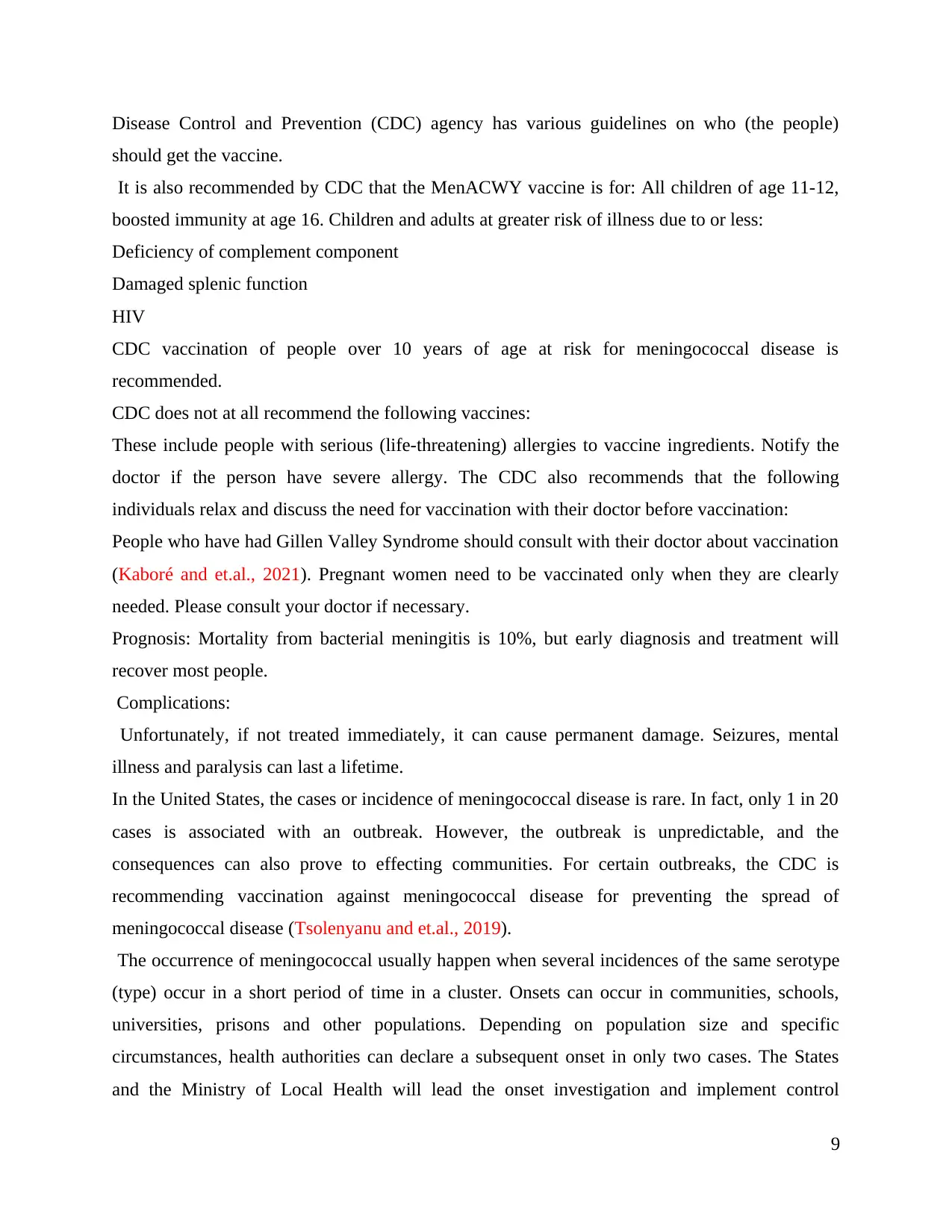
Disease Control and Prevention (CDC) agency has various guidelines on who (the people)
should get the vaccine.
It is also recommended by CDC that the MenACWY vaccine is for: All children of age 11-12,
boosted immunity at age 16. Children and adults at greater risk of illness due to or less:
Deficiency of complement component
Damaged splenic function
HIV
CDC vaccination of people over 10 years of age at risk for meningococcal disease is
recommended.
CDC does not at all recommend the following vaccines:
These include people with serious (life-threatening) allergies to vaccine ingredients. Notify the
doctor if the person have severe allergy. The CDC also recommends that the following
individuals relax and discuss the need for vaccination with their doctor before vaccination:
People who have had Gillen Valley Syndrome should consult with their doctor about vaccination
(Kaboré and et.al., 2021). Pregnant women need to be vaccinated only when they are clearly
needed. Please consult your doctor if necessary.
Prognosis: Mortality from bacterial meningitis is 10%, but early diagnosis and treatment will
recover most people.
Complications:
Unfortunately, if not treated immediately, it can cause permanent damage. Seizures, mental
illness and paralysis can last a lifetime.
In the United States, the cases or incidence of meningococcal disease is rare. In fact, only 1 in 20
cases is associated with an outbreak. However, the outbreak is unpredictable, and the
consequences can also prove to effecting communities. For certain outbreaks, the CDC is
recommending vaccination against meningococcal disease for preventing the spread of
meningococcal disease (Tsolenyanu and et.al., 2019).
The occurrence of meningococcal usually happen when several incidences of the same serotype
(type) occur in a short period of time in a cluster. Onsets can occur in communities, schools,
universities, prisons and other populations. Depending on population size and specific
circumstances, health authorities can declare a subsequent onset in only two cases. The States
and the Ministry of Local Health will lead the onset investigation and implement control
9
should get the vaccine.
It is also recommended by CDC that the MenACWY vaccine is for: All children of age 11-12,
boosted immunity at age 16. Children and adults at greater risk of illness due to or less:
Deficiency of complement component
Damaged splenic function
HIV
CDC vaccination of people over 10 years of age at risk for meningococcal disease is
recommended.
CDC does not at all recommend the following vaccines:
These include people with serious (life-threatening) allergies to vaccine ingredients. Notify the
doctor if the person have severe allergy. The CDC also recommends that the following
individuals relax and discuss the need for vaccination with their doctor before vaccination:
People who have had Gillen Valley Syndrome should consult with their doctor about vaccination
(Kaboré and et.al., 2021). Pregnant women need to be vaccinated only when they are clearly
needed. Please consult your doctor if necessary.
Prognosis: Mortality from bacterial meningitis is 10%, but early diagnosis and treatment will
recover most people.
Complications:
Unfortunately, if not treated immediately, it can cause permanent damage. Seizures, mental
illness and paralysis can last a lifetime.
In the United States, the cases or incidence of meningococcal disease is rare. In fact, only 1 in 20
cases is associated with an outbreak. However, the outbreak is unpredictable, and the
consequences can also prove to effecting communities. For certain outbreaks, the CDC is
recommending vaccination against meningococcal disease for preventing the spread of
meningococcal disease (Tsolenyanu and et.al., 2019).
The occurrence of meningococcal usually happen when several incidences of the same serotype
(type) occur in a short period of time in a cluster. Onsets can occur in communities, schools,
universities, prisons and other populations. Depending on population size and specific
circumstances, health authorities can declare a subsequent onset in only two cases. The States
and the Ministry of Local Health will lead the onset investigation and implement control
9
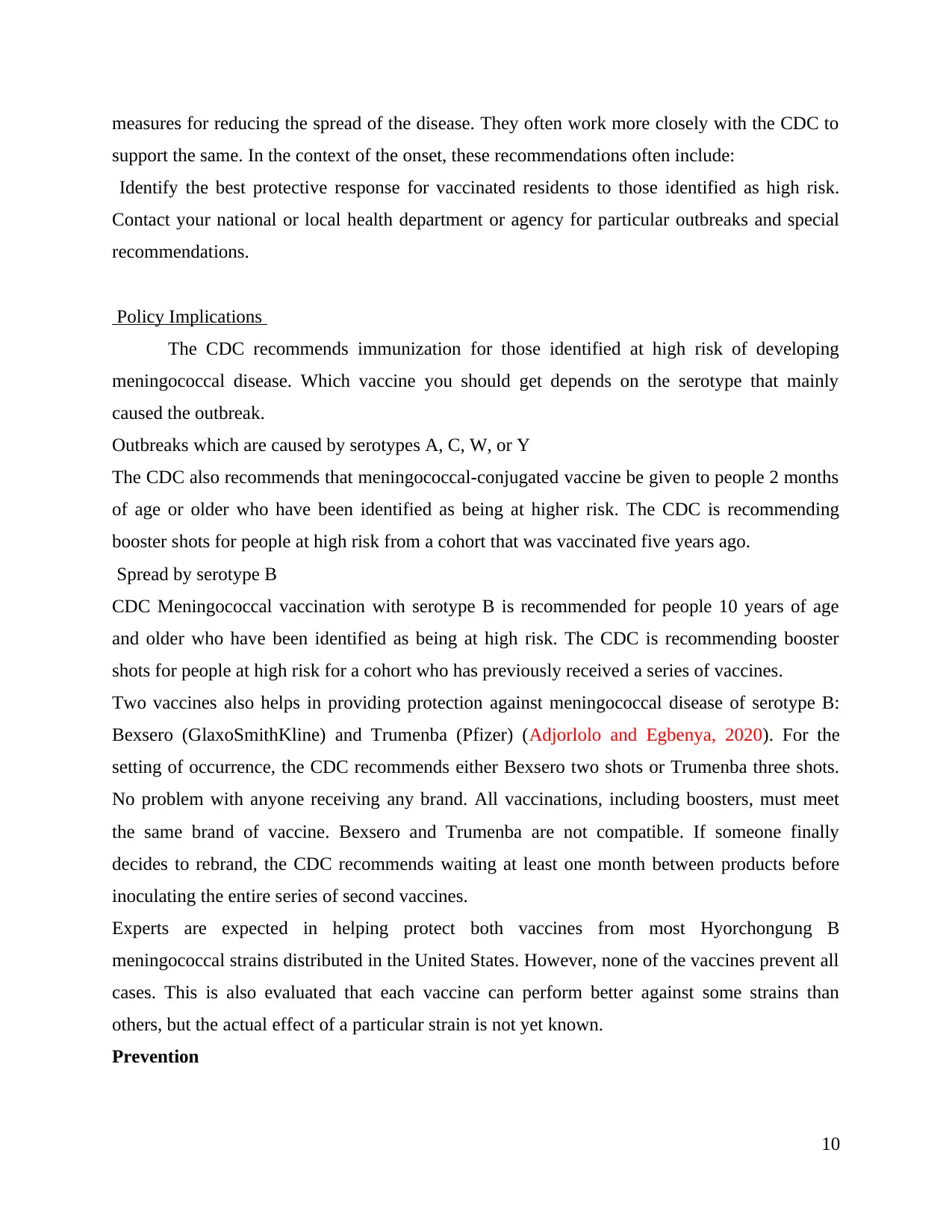
measures for reducing the spread of the disease. They often work more closely with the CDC to
support the same. In the context of the onset, these recommendations often include:
Identify the best protective response for vaccinated residents to those identified as high risk.
Contact your national or local health department or agency for particular outbreaks and special
recommendations.
Policy Implications
The CDC recommends immunization for those identified at high risk of developing
meningococcal disease. Which vaccine you should get depends on the serotype that mainly
caused the outbreak.
Outbreaks which are caused by serotypes A, C, W, or Y
The CDC also recommends that meningococcal-conjugated vaccine be given to people 2 months
of age or older who have been identified as being at higher risk. The CDC is recommending
booster shots for people at high risk from a cohort that was vaccinated five years ago.
Spread by serotype B
CDC Meningococcal vaccination with serotype B is recommended for people 10 years of age
and older who have been identified as being at high risk. The CDC is recommending booster
shots for people at high risk for a cohort who has previously received a series of vaccines.
Two vaccines also helps in providing protection against meningococcal disease of serotype B:
Bexsero (GlaxoSmithKline) and Trumenba (Pfizer) (Adjorlolo and Egbenya, 2020). For the
setting of occurrence, the CDC recommends either Bexsero two shots or Trumenba three shots.
No problem with anyone receiving any brand. All vaccinations, including boosters, must meet
the same brand of vaccine. Bexsero and Trumenba are not compatible. If someone finally
decides to rebrand, the CDC recommends waiting at least one month between products before
inoculating the entire series of second vaccines.
Experts are expected in helping protect both vaccines from most Hyorchongung B
meningococcal strains distributed in the United States. However, none of the vaccines prevent all
cases. This is also evaluated that each vaccine can perform better against some strains than
others, but the actual effect of a particular strain is not yet known.
Prevention
10
support the same. In the context of the onset, these recommendations often include:
Identify the best protective response for vaccinated residents to those identified as high risk.
Contact your national or local health department or agency for particular outbreaks and special
recommendations.
Policy Implications
The CDC recommends immunization for those identified at high risk of developing
meningococcal disease. Which vaccine you should get depends on the serotype that mainly
caused the outbreak.
Outbreaks which are caused by serotypes A, C, W, or Y
The CDC also recommends that meningococcal-conjugated vaccine be given to people 2 months
of age or older who have been identified as being at higher risk. The CDC is recommending
booster shots for people at high risk from a cohort that was vaccinated five years ago.
Spread by serotype B
CDC Meningococcal vaccination with serotype B is recommended for people 10 years of age
and older who have been identified as being at high risk. The CDC is recommending booster
shots for people at high risk for a cohort who has previously received a series of vaccines.
Two vaccines also helps in providing protection against meningococcal disease of serotype B:
Bexsero (GlaxoSmithKline) and Trumenba (Pfizer) (Adjorlolo and Egbenya, 2020). For the
setting of occurrence, the CDC recommends either Bexsero two shots or Trumenba three shots.
No problem with anyone receiving any brand. All vaccinations, including boosters, must meet
the same brand of vaccine. Bexsero and Trumenba are not compatible. If someone finally
decides to rebrand, the CDC recommends waiting at least one month between products before
inoculating the entire series of second vaccines.
Experts are expected in helping protect both vaccines from most Hyorchongung B
meningococcal strains distributed in the United States. However, none of the vaccines prevent all
cases. This is also evaluated that each vaccine can perform better against some strains than
others, but the actual effect of a particular strain is not yet known.
Prevention
10
Secure Best Marks with AI Grader
Need help grading? Try our AI Grader for instant feedback on your assignments.
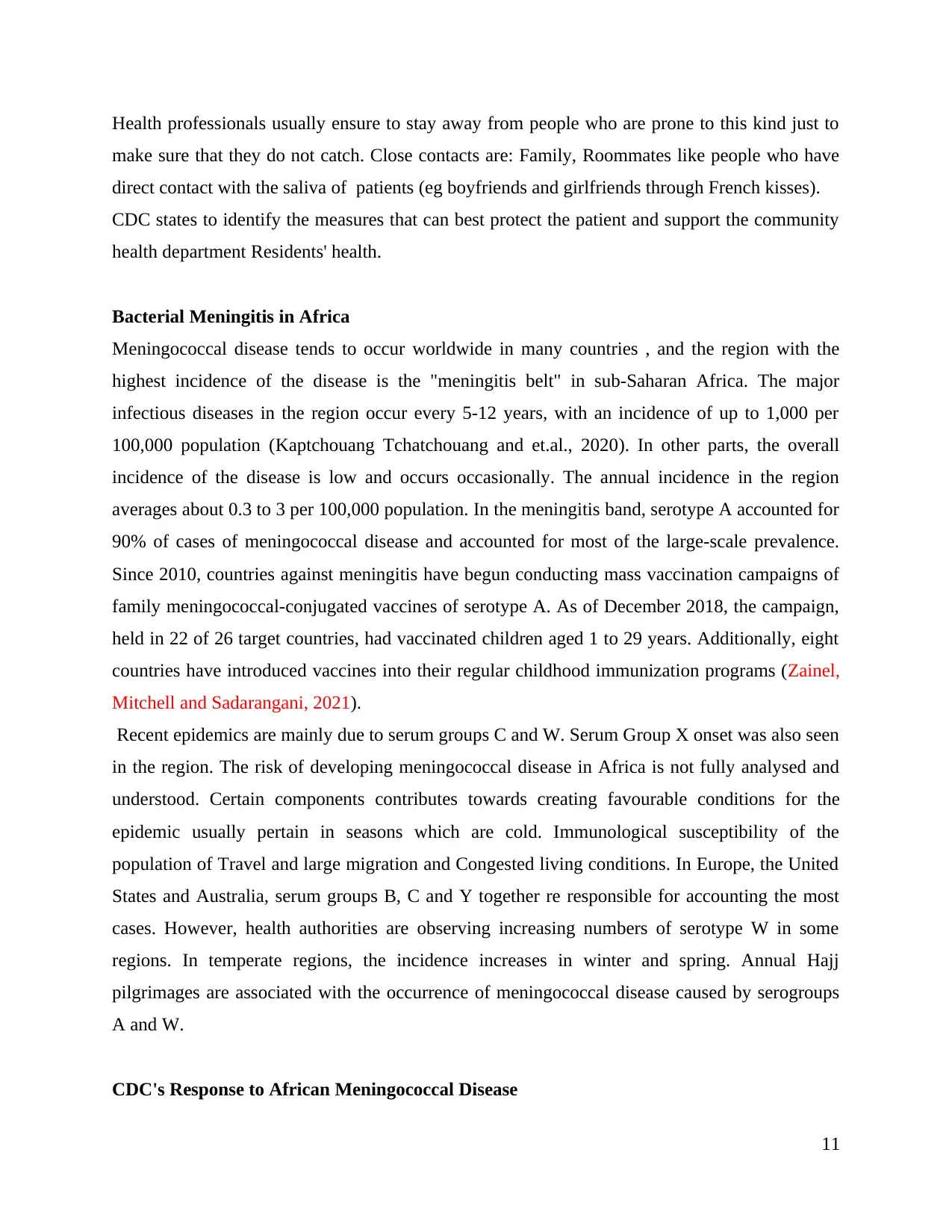
Health professionals usually ensure to stay away from people who are prone to this kind just to
make sure that they do not catch. Close contacts are: Family, Roommates like people who have
direct contact with the saliva of patients (eg boyfriends and girlfriends through French kisses).
CDC states to identify the measures that can best protect the patient and support the community
health department Residents' health.
Bacterial Meningitis in Africa
Meningococcal disease tends to occur worldwide in many countries , and the region with the
highest incidence of the disease is the "meningitis belt" in sub-Saharan Africa. The major
infectious diseases in the region occur every 5-12 years, with an incidence of up to 1,000 per
100,000 population (Kaptchouang Tchatchouang and et.al., 2020). In other parts, the overall
incidence of the disease is low and occurs occasionally. The annual incidence in the region
averages about 0.3 to 3 per 100,000 population. In the meningitis band, serotype A accounted for
90% of cases of meningococcal disease and accounted for most of the large-scale prevalence.
Since 2010, countries against meningitis have begun conducting mass vaccination campaigns of
family meningococcal-conjugated vaccines of serotype A. As of December 2018, the campaign,
held in 22 of 26 target countries, had vaccinated children aged 1 to 29 years. Additionally, eight
countries have introduced vaccines into their regular childhood immunization programs (Zainel,
Mitchell and Sadarangani, 2021).
Recent epidemics are mainly due to serum groups C and W. Serum Group X onset was also seen
in the region. The risk of developing meningococcal disease in Africa is not fully analysed and
understood. Certain components contributes towards creating favourable conditions for the
epidemic usually pertain in seasons which are cold. Immunological susceptibility of the
population of Travel and large migration and Congested living conditions. In Europe, the United
States and Australia, serum groups B, C and Y together re responsible for accounting the most
cases. However, health authorities are observing increasing numbers of serotype W in some
regions. In temperate regions, the incidence increases in winter and spring. Annual Hajj
pilgrimages are associated with the occurrence of meningococcal disease caused by serogroups
A and W.
CDC's Response to African Meningococcal Disease
11
make sure that they do not catch. Close contacts are: Family, Roommates like people who have
direct contact with the saliva of patients (eg boyfriends and girlfriends through French kisses).
CDC states to identify the measures that can best protect the patient and support the community
health department Residents' health.
Bacterial Meningitis in Africa
Meningococcal disease tends to occur worldwide in many countries , and the region with the
highest incidence of the disease is the "meningitis belt" in sub-Saharan Africa. The major
infectious diseases in the region occur every 5-12 years, with an incidence of up to 1,000 per
100,000 population (Kaptchouang Tchatchouang and et.al., 2020). In other parts, the overall
incidence of the disease is low and occurs occasionally. The annual incidence in the region
averages about 0.3 to 3 per 100,000 population. In the meningitis band, serotype A accounted for
90% of cases of meningococcal disease and accounted for most of the large-scale prevalence.
Since 2010, countries against meningitis have begun conducting mass vaccination campaigns of
family meningococcal-conjugated vaccines of serotype A. As of December 2018, the campaign,
held in 22 of 26 target countries, had vaccinated children aged 1 to 29 years. Additionally, eight
countries have introduced vaccines into their regular childhood immunization programs (Zainel,
Mitchell and Sadarangani, 2021).
Recent epidemics are mainly due to serum groups C and W. Serum Group X onset was also seen
in the region. The risk of developing meningococcal disease in Africa is not fully analysed and
understood. Certain components contributes towards creating favourable conditions for the
epidemic usually pertain in seasons which are cold. Immunological susceptibility of the
population of Travel and large migration and Congested living conditions. In Europe, the United
States and Australia, serum groups B, C and Y together re responsible for accounting the most
cases. However, health authorities are observing increasing numbers of serotype W in some
regions. In temperate regions, the incidence increases in winter and spring. Annual Hajj
pilgrimages are associated with the occurrence of meningococcal disease caused by serogroups
A and W.
CDC's Response to African Meningococcal Disease
11
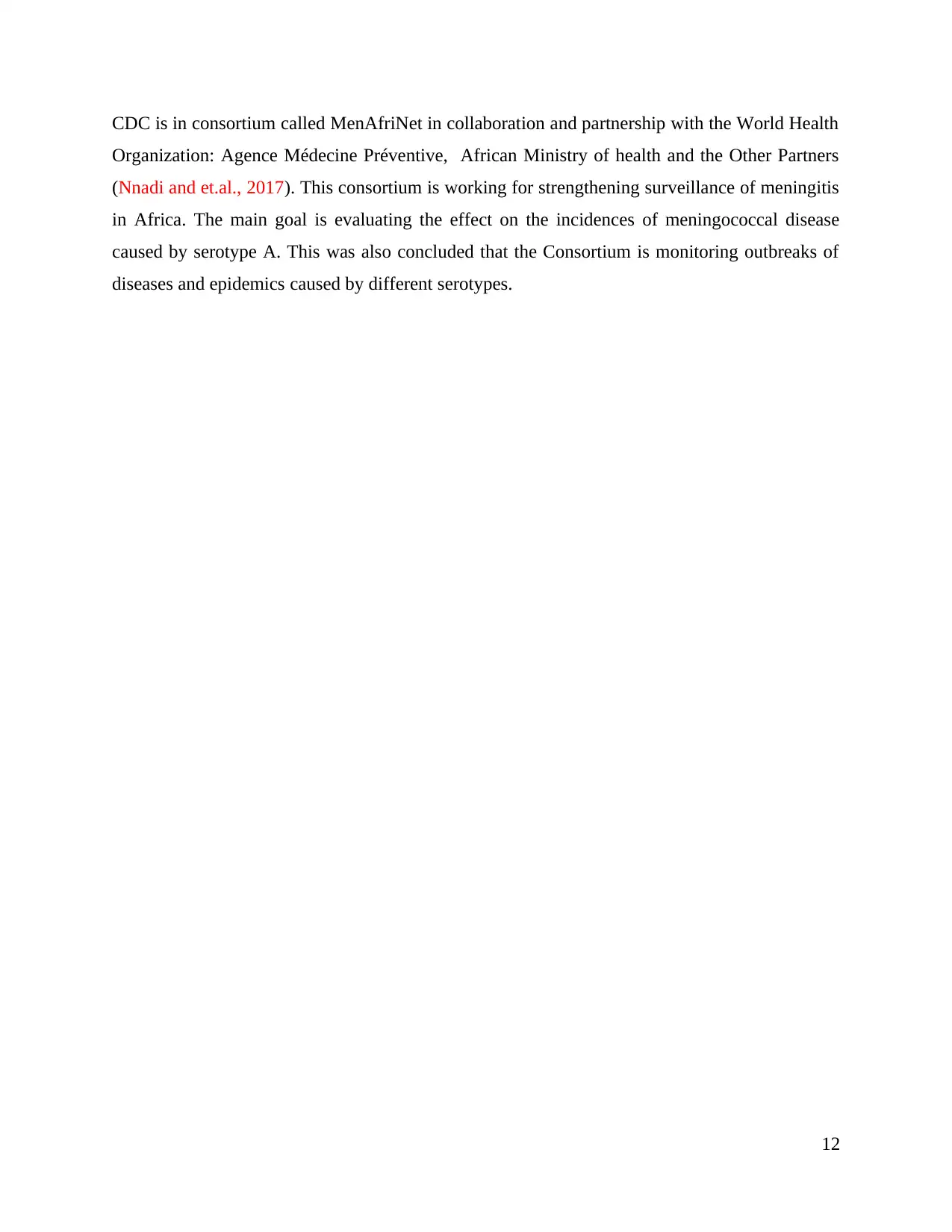
CDC is in consortium called MenAfriNet in collaboration and partnership with the World Health
Organization: Agence Médecine Préventive, African Ministry of health and the Other Partners
(Nnadi and et.al., 2017). This consortium is working for strengthening surveillance of meningitis
in Africa. The main goal is evaluating the effect on the incidences of meningococcal disease
caused by serotype A. This was also concluded that the Consortium is monitoring outbreaks of
diseases and epidemics caused by different serotypes.
12
Organization: Agence Médecine Préventive, African Ministry of health and the Other Partners
(Nnadi and et.al., 2017). This consortium is working for strengthening surveillance of meningitis
in Africa. The main goal is evaluating the effect on the incidences of meningococcal disease
caused by serotype A. This was also concluded that the Consortium is monitoring outbreaks of
diseases and epidemics caused by different serotypes.
12
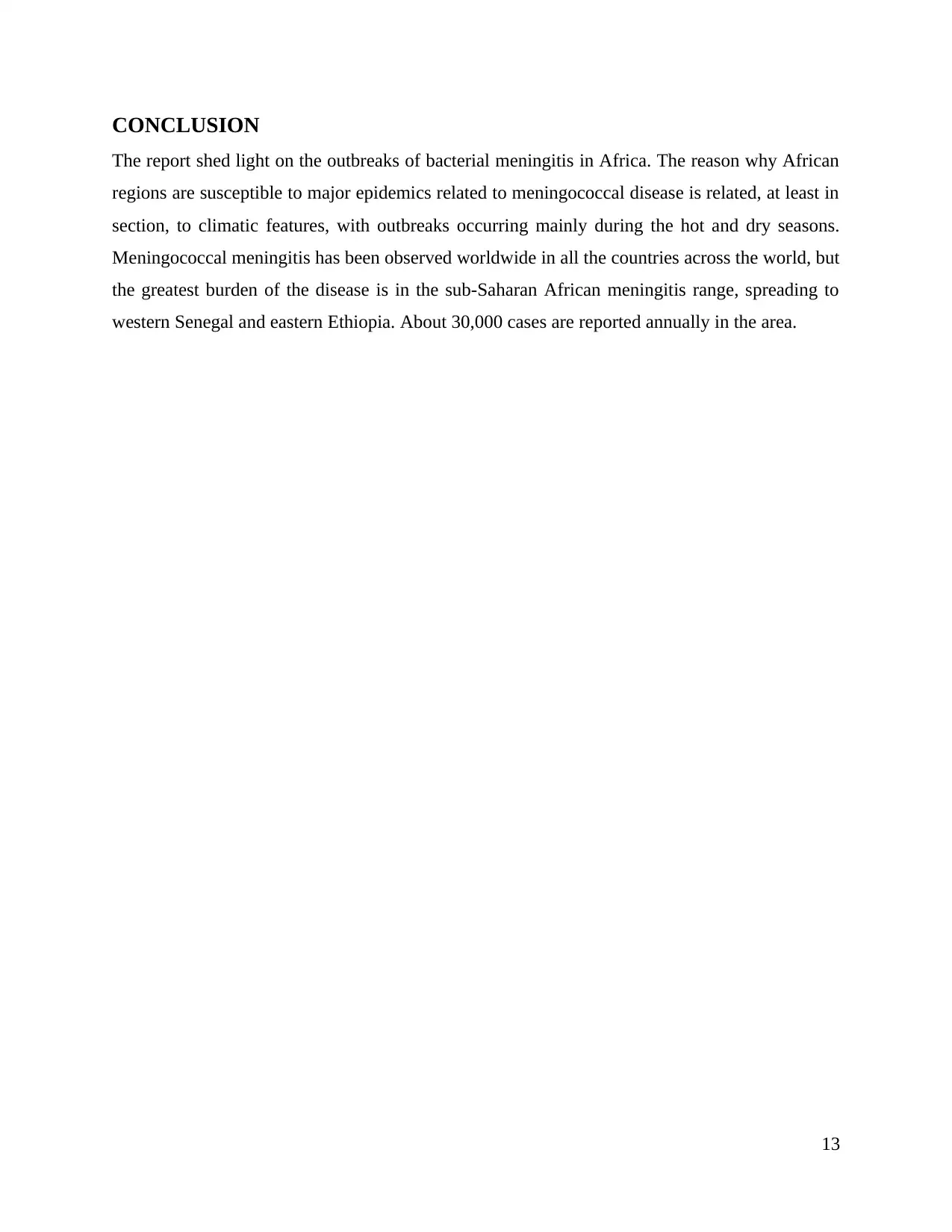
CONCLUSION
The report shed light on the outbreaks of bacterial meningitis in Africa. The reason why African
regions are susceptible to major epidemics related to meningococcal disease is related, at least in
section, to climatic features, with outbreaks occurring mainly during the hot and dry seasons.
Meningococcal meningitis has been observed worldwide in all the countries across the world, but
the greatest burden of the disease is in the sub-Saharan African meningitis range, spreading to
western Senegal and eastern Ethiopia. About 30,000 cases are reported annually in the area.
13
The report shed light on the outbreaks of bacterial meningitis in Africa. The reason why African
regions are susceptible to major epidemics related to meningococcal disease is related, at least in
section, to climatic features, with outbreaks occurring mainly during the hot and dry seasons.
Meningococcal meningitis has been observed worldwide in all the countries across the world, but
the greatest burden of the disease is in the sub-Saharan African meningitis range, spreading to
western Senegal and eastern Ethiopia. About 30,000 cases are reported annually in the area.
13
Paraphrase This Document
Need a fresh take? Get an instant paraphrase of this document with our AI Paraphraser
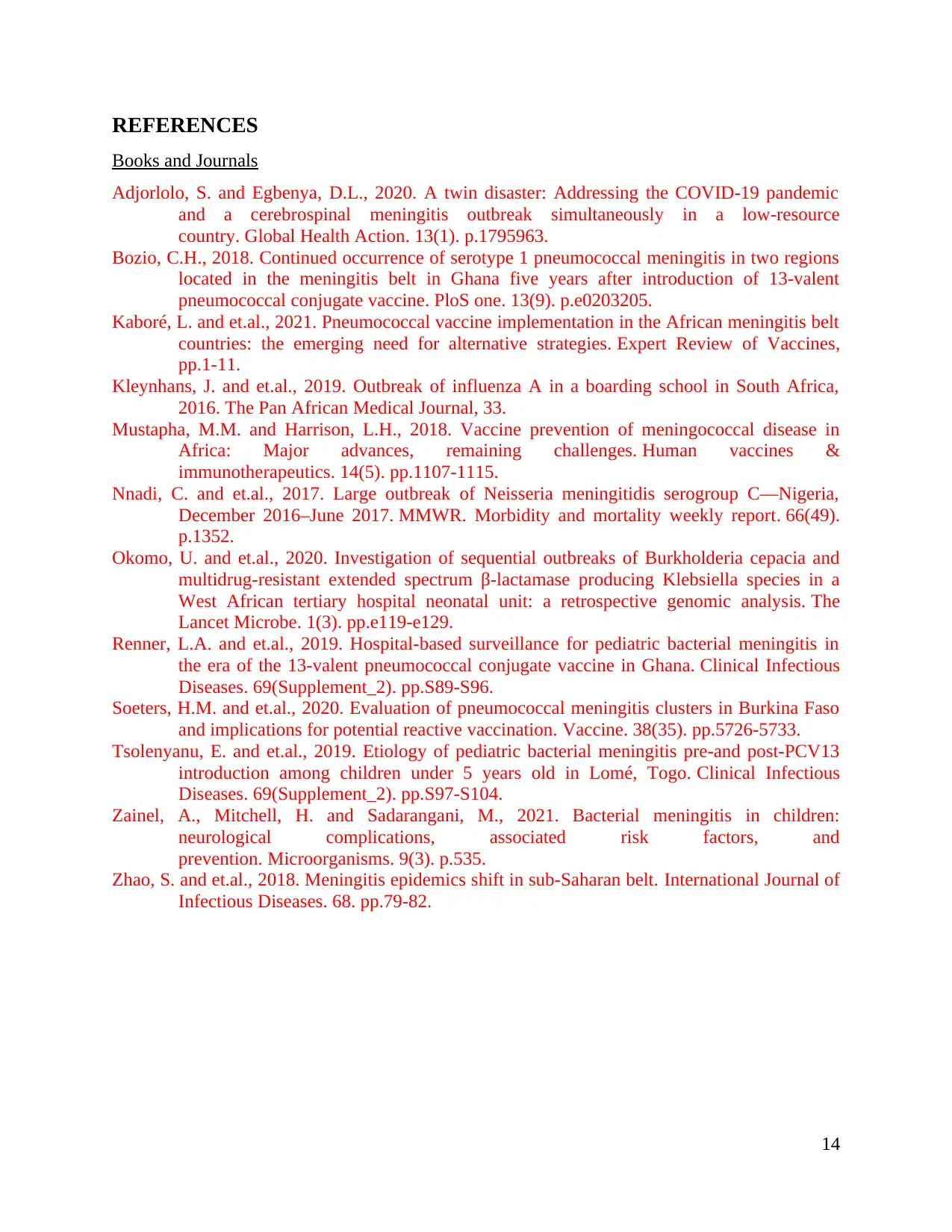
REFERENCES
Books and Journals
Adjorlolo, S. and Egbenya, D.L., 2020. A twin disaster: Addressing the COVID-19 pandemic
and a cerebrospinal meningitis outbreak simultaneously in a low-resource
country. Global Health Action. 13(1). p.1795963.
Bozio, C.H., 2018. Continued occurrence of serotype 1 pneumococcal meningitis in two regions
located in the meningitis belt in Ghana five years after introduction of 13-valent
pneumococcal conjugate vaccine. PloS one. 13(9). p.e0203205.
Kaboré, L. and et.al., 2021. Pneumococcal vaccine implementation in the African meningitis belt
countries: the emerging need for alternative strategies. Expert Review of Vaccines,
pp.1-11.
Kleynhans, J. and et.al., 2019. Outbreak of influenza A in a boarding school in South Africa,
2016. The Pan African Medical Journal, 33.
Mustapha, M.M. and Harrison, L.H., 2018. Vaccine prevention of meningococcal disease in
Africa: Major advances, remaining challenges. Human vaccines &
immunotherapeutics. 14(5). pp.1107-1115.
Nnadi, C. and et.al., 2017. Large outbreak of Neisseria meningitidis serogroup C—Nigeria,
December 2016–June 2017. MMWR. Morbidity and mortality weekly report. 66(49).
p.1352.
Okomo, U. and et.al., 2020. Investigation of sequential outbreaks of Burkholderia cepacia and
multidrug-resistant extended spectrum β-lactamase producing Klebsiella species in a
West African tertiary hospital neonatal unit: a retrospective genomic analysis. The
Lancet Microbe. 1(3). pp.e119-e129.
Renner, L.A. and et.al., 2019. Hospital-based surveillance for pediatric bacterial meningitis in
the era of the 13-valent pneumococcal conjugate vaccine in Ghana. Clinical Infectious
Diseases. 69(Supplement_2). pp.S89-S96.
Soeters, H.M. and et.al., 2020. Evaluation of pneumococcal meningitis clusters in Burkina Faso
and implications for potential reactive vaccination. Vaccine. 38(35). pp.5726-5733.
Tsolenyanu, E. and et.al., 2019. Etiology of pediatric bacterial meningitis pre-and post-PCV13
introduction among children under 5 years old in Lomé, Togo. Clinical Infectious
Diseases. 69(Supplement_2). pp.S97-S104.
Zainel, A., Mitchell, H. and Sadarangani, M., 2021. Bacterial meningitis in children:
neurological complications, associated risk factors, and
prevention. Microorganisms. 9(3). p.535.
Zhao, S. and et.al., 2018. Meningitis epidemics shift in sub-Saharan belt. International Journal of
Infectious Diseases. 68. pp.79-82.
14
Books and Journals
Adjorlolo, S. and Egbenya, D.L., 2020. A twin disaster: Addressing the COVID-19 pandemic
and a cerebrospinal meningitis outbreak simultaneously in a low-resource
country. Global Health Action. 13(1). p.1795963.
Bozio, C.H., 2018. Continued occurrence of serotype 1 pneumococcal meningitis in two regions
located in the meningitis belt in Ghana five years after introduction of 13-valent
pneumococcal conjugate vaccine. PloS one. 13(9). p.e0203205.
Kaboré, L. and et.al., 2021. Pneumococcal vaccine implementation in the African meningitis belt
countries: the emerging need for alternative strategies. Expert Review of Vaccines,
pp.1-11.
Kleynhans, J. and et.al., 2019. Outbreak of influenza A in a boarding school in South Africa,
2016. The Pan African Medical Journal, 33.
Mustapha, M.M. and Harrison, L.H., 2018. Vaccine prevention of meningococcal disease in
Africa: Major advances, remaining challenges. Human vaccines &
immunotherapeutics. 14(5). pp.1107-1115.
Nnadi, C. and et.al., 2017. Large outbreak of Neisseria meningitidis serogroup C—Nigeria,
December 2016–June 2017. MMWR. Morbidity and mortality weekly report. 66(49).
p.1352.
Okomo, U. and et.al., 2020. Investigation of sequential outbreaks of Burkholderia cepacia and
multidrug-resistant extended spectrum β-lactamase producing Klebsiella species in a
West African tertiary hospital neonatal unit: a retrospective genomic analysis. The
Lancet Microbe. 1(3). pp.e119-e129.
Renner, L.A. and et.al., 2019. Hospital-based surveillance for pediatric bacterial meningitis in
the era of the 13-valent pneumococcal conjugate vaccine in Ghana. Clinical Infectious
Diseases. 69(Supplement_2). pp.S89-S96.
Soeters, H.M. and et.al., 2020. Evaluation of pneumococcal meningitis clusters in Burkina Faso
and implications for potential reactive vaccination. Vaccine. 38(35). pp.5726-5733.
Tsolenyanu, E. and et.al., 2019. Etiology of pediatric bacterial meningitis pre-and post-PCV13
introduction among children under 5 years old in Lomé, Togo. Clinical Infectious
Diseases. 69(Supplement_2). pp.S97-S104.
Zainel, A., Mitchell, H. and Sadarangani, M., 2021. Bacterial meningitis in children:
neurological complications, associated risk factors, and
prevention. Microorganisms. 9(3). p.535.
Zhao, S. and et.al., 2018. Meningitis epidemics shift in sub-Saharan belt. International Journal of
Infectious Diseases. 68. pp.79-82.
14
1 out of 14
Related Documents
Your All-in-One AI-Powered Toolkit for Academic Success.
+13062052269
info@desklib.com
Available 24*7 on WhatsApp / Email
![[object Object]](/_next/static/media/star-bottom.7253800d.svg)
Unlock your academic potential
© 2024 | Zucol Services PVT LTD | All rights reserved.





